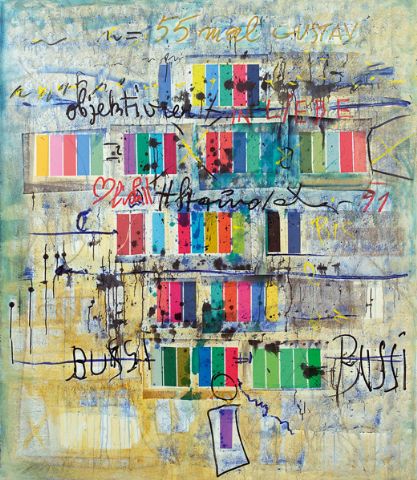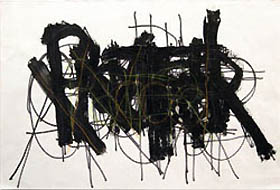..
With a name like that, you can pretty much tell he's not Italian. And most of the sites where you'll find images of his work are not in English either. I've been collecting info on him for a while and thought this would be as good a time as any to do this post so as to concentrate on the up coming project.
A while back, over the course of several posts, I presented the work of Stefan Anneral who used various kinds of tapes and paint in his very colorful work. (He's listed in the links on the right side of the blog under ABSTRACT LINKS) Further searching produced more information on his oeuvre, revealing that there is much more than what first meets the eye. At some point a more informed post about him will be forthcoming.Technically, this type work would be categorized as collage and it challenges us the way he uses common materials and turns them into glowing gems. Once again we reconsider what "artistic" materials are and can be.

And that brings us to
Kees Goudzwaard. Here we have another artist interested in using tape, but it looks like he's intent on exploring the possibilities of using only masking tape on a solid colored background. Or so I thought.
After seeing Stefan's work with the tape and then finding
Kees, I thought it was more of the same; slightly different, but tape and paint on a support none the less. Come to find out, these are not collage but in fact oil paintings and only oil paintings. Kees makes a model on canvas using sheets of colored paper and strips, bits and pieces of masking tape and then replaces what he's constructed with oil paint. He also does it in a smooth finish so there are no traces of the artist.
So on the one hand we're looking at such a simple, almost minimal work that looks as though the artist just took pieces of tape and affixed them to the canvas, as in fact he did, but what we're really viewing is a hyper realistic oil painting OF what we thought we saw. In other words this is really good trompe l’oeil, not collage.
The first piece I ever encountered on the Internet by Kees Goudzwaard had a soft blue ground and the immediate "reading" was that it was some sort of blueprint. Both colors were in the right range and reminded me of how certain blueprints come across more as a work of art than a functional document. For lack of a better way, lets say the red work falls into the "blueprint" category. It really is something to view these as though they were simply what they look like - an artist putting bits of masking tape to canvas. The whole idea of what makes art and what are artistic materials, comes to mind. Then upon coming to terms with the fact that these are skilled oil paintings, so much more is added to the equation.

To read more about him go
HERE and
HERE .
He's represented by the Zeno X Gallery and when you go to
THIS page, not only can you see his work and enlargements, you can also see each work in a "view" inside the gallery, which also enlarges. VERY nice concept. Check it out.
Red
image is from S.M.A.K.Top and bottom images are from Zeno-x.com
Other images can be found
Here,
Here,
Here,
Here,
Here and
Here.
..










































 It's been long enough now that I don't remember when, but Dale and I went to see all the art galleries in Old City, Philadelphia, PA. What a cool experience. So there's Gallery Joe across the street. we walk over and go into this tiny establishment that specializes in drawing. There's a small front gallery and then we walked 'round into what used to be an old vault and there were three watercolor panel just hanging there. As we stood in that small, quiet room and looked at the monochrome scene before us, we were transported out into the cold silent woods. You could almost hear the snow falling and maybe a Chickadee nearby. Talk about your virtual experiences . . .
It's been long enough now that I don't remember when, but Dale and I went to see all the art galleries in Old City, Philadelphia, PA. What a cool experience. So there's Gallery Joe across the street. we walk over and go into this tiny establishment that specializes in drawing. There's a small front gallery and then we walked 'round into what used to be an old vault and there were three watercolor panel just hanging there. As we stood in that small, quiet room and looked at the monochrome scene before us, we were transported out into the cold silent woods. You could almost hear the snow falling and maybe a Chickadee nearby. Talk about your virtual experiences . . . 



